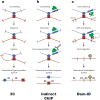Chromatin loops in gene regulation
- PMID: 18675948
- PMCID: PMC2638769
- DOI: 10.1016/j.bbagrm.2008.07.002
Chromatin loops in gene regulation
Abstract
The control of gene expression involves regulatory elements that can be very far from the genes they control. Several recent technological advances have allowed the direct detection of chromatin loops that juxtapose distant genomic sites in the nucleus. Here we review recent studies from various model organisms that have provided new insights into the functions of chromatin loops and the mechanisms that form them. We discuss the widespread impact of chromatin loops on gene activation, repression, genomic imprinting and the function of enhancers and insulators.
Figures

References
-
- Engel JD, Tanimoto K. Looping, linking, and chromatin activity: new insights into beta-globin locus regulation. Cell. 2000;100:499–502. - PubMed
-
- Bulger M, Groudine M. Looping versus linking: toward a model for long-distance gene activation. Genes Dev. 1999;13:2465–77. - PubMed
-
- Martin DI, Fiering S, Groudine M. Regulation of beta-globin gene expression: straightening out the locus. Curr Opin Genet Dev. 1996;6:488–95. - PubMed
-
- Blackwood EM, Kadonaga JT. Going the distance: a current view of enhancer action. Science. 1998;281:60–3. - PubMed
-
- Chambeyron S, Bickmore WA. Does looping and clustering in the nucleus regulate gene expression? Curr Opin Cell Biol. 2004;16:256–62. - PubMed
Publication types
MeSH terms
Substances
Grants and funding
LinkOut - more resources
Full Text Sources
Other Literature Sources

